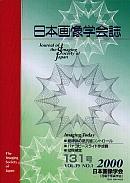All issues

Volume 53 (2014)
- Issue 6 Pages 476-
- Issue 5 Pages 392-
- Issue 4 Pages 252-
- Issue 3 Pages 174-
- Issue 2 Pages 112-
- Issue 1 Pages 2-
Volume 53, Issue 2
Displaying 1-7 of 7 articles from this issue
- |<
- <
- 1
- >
- >|
Original Paper
-
Kazunori TANAKA, Mitsuko NISHIURA2014Volume 53Issue 2 Pages 112-117
Published: April 10, 2014
Released on J-STAGE: April 13, 2014
JOURNAL FREE ACCESSThe values of color difference ΔE*ab in the uniform color space CIELAB (CIE1976) are known not to correspond to the visual color difference in some cases. CIE recommends the CIEDE2000 formula for color difference evaluation because of the good agreement between the calculation results and the visual differences. This formula was developed based on the evaluations using samples with color differences on the background of Munsell N5 gray. However, in the case of evaluations of printed documents on white paper, we can not use this formula as it is, since the evaluation conditions differ from each other. In this paper, we report that we conducted the evaluations of acceptable color difference using printed documents on the background of plain white paper and developed a color-difference formula for printed documents. We also report the comparison results of performance between CIEDE2000 and our developed formula.View full abstractDownload PDF (555K)
Imaging Today
-
Shuichi YAMAGUCHI2014Volume 53Issue 2 Pages 119-127
Published: April 10, 2014
Released on J-STAGE: April 13, 2014
JOURNAL FREE ACCESSSince last year, 3D printer has been a topic of conversation in Japan. Having touched on the history of 3D printing technology development, this article describes the principles and features of typical 3D printing methods in the mainstream of industry, and introduces the application fields of printed objects by each method. In those printing methods, inkjet technology which has been widely applied as printing method for characters and images is picked up, followed by explanations of the technical points on 3D printing which differs from 2-dimensional printing. Upon listing up the current issues of 3D printers, the future direction of technology development will be described. Finally, the proposal how to utilize 3D printer into manufacturing industry in Japan, and how to tackle the tasks for its implementation, will be addressed. It concludes that intensive R & D for inkjet technology where Japan has strength should be carried out, by one Japan regardless of company name, towards the era of “3D Printer 3.0”.View full abstractDownload PDF (1240K) -
Yukitoshi OTANI2014Volume 53Issue 2 Pages 128-135
Published: April 10, 2014
Released on J-STAGE: April 13, 2014
JOURNAL FREE ACCESSIn recent years, a 3D printing attracts attention for the new three-dimensional technology. Although a CAD and CG areas are generally treated 3D data within a computer, there are no 3D data in the field of industrial products and medical treatments, such as a human body and a clay model. Three-dimensional profilometry by imaging technology is required in this field. It has features for non contact and non destructive so it has been researched and developed in not only universities but the industrial field. In this paper, we focus a confocal point method (focal method), a triangulation method, a light sectioning method, a stereo method, grating pattern projection method, and the time of flight method (TOF) as these typical techniques and reviewing a principle and discussing a future view of the 3D profilometry.View full abstractDownload PDF (1428K) -
Satoshi MACHIDA2014Volume 53Issue 2 Pages 136-141
Published: April 10, 2014
Released on J-STAGE: April 13, 2014
JOURNAL FREE ACCESSProjection mapping is an expressive technology in which a video projector is used to projection images onto a three-dimensional “object” such as an architectural structure or sometimes a tree, moving person, etc., rather than a square screen. From a technological aspect, projection mapping is the process of creating the desired expression through a combination of conventional 3DCG technology, image processing technology and projection technology. This paper provides an overview of the relationship between projection mapping and conventional technologies, as well as a new workflow using a 3D printer.View full abstractDownload PDF (1596K) -
Takafumi SAITO2014Volume 53Issue 2 Pages 142-146
Published: April 10, 2014
Released on J-STAGE: April 13, 2014
JOURNAL FREE ACCESSRecently, in CG research field, many studies on 3D printing have been done for efficient manufacturing and new application development. In this article, such research trends are introduced with recent research papers presented in ACM SIGGRAPH and SIGGRAPH Asia.
As for efficiency of 3D printing, shape optimization and structural strength improvement have been investigated. New application development includes various shape creation, fabrication of deformable shapes and mechanical structures, and control of optical characteristics.
In addition, as an author's original study, view dependent relief surfaces are introduced.View full abstractDownload PDF (818K)
Lectures in Science
-
Ken'ichi KOSEKI2014Volume 53Issue 2 Pages 147-149
Published: April 10, 2014
Released on J-STAGE: April 13, 2014
JOURNAL RESTRICTED ACCESSDownload PDF (455K)
Errata
-
K.K. Chamili KUMARA, Sakiko NAKAMURA, Nobukazu MIYAGAWA, Takashi KITAM ...2014Volume 53Issue 2 Pages 160
Published: April 10, 2014
Released on J-STAGE: August 02, 2016
JOURNAL FREE ACCESSDownload PDF (35K)
- |<
- <
- 1
- >
- >|